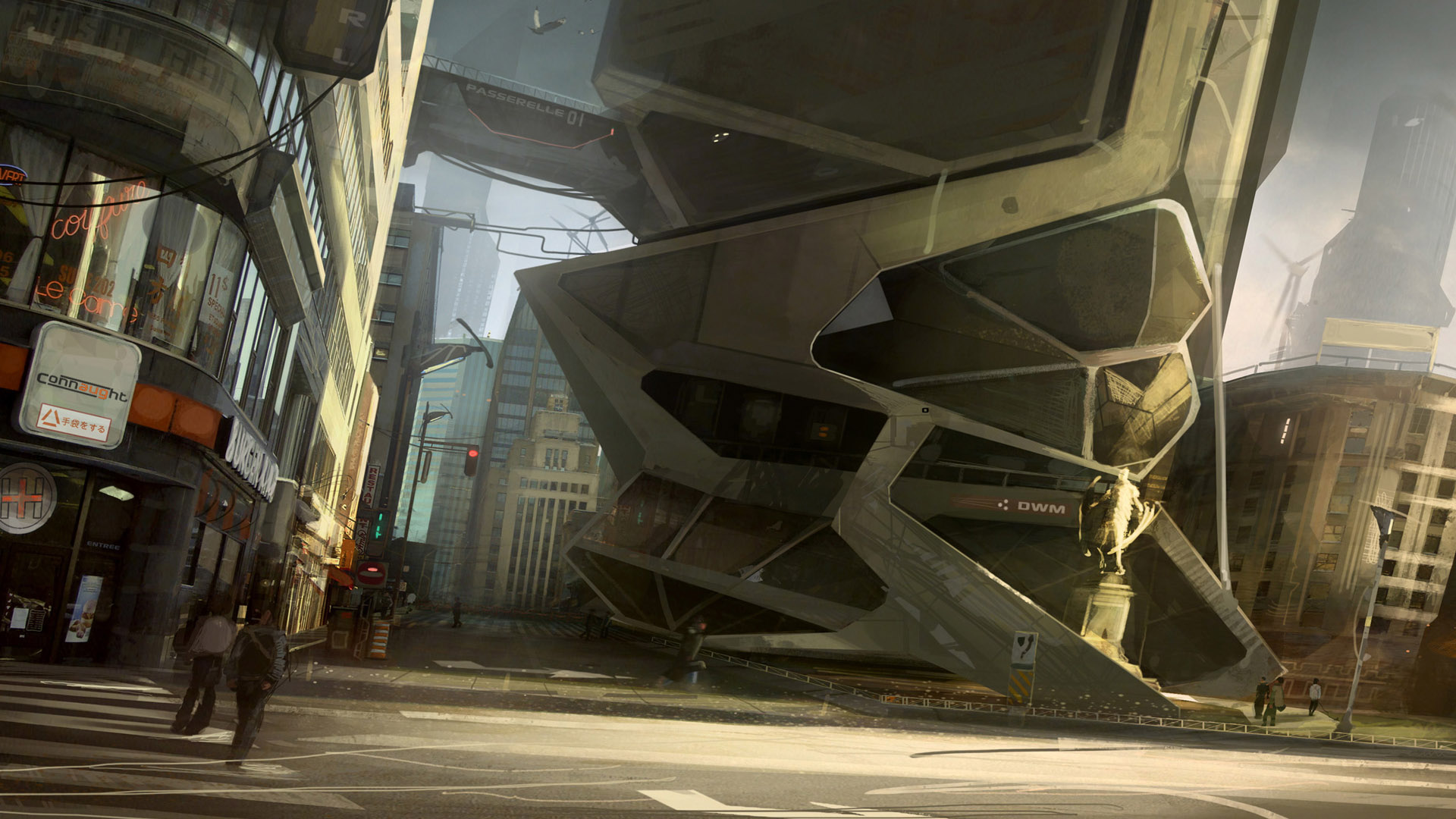.
I'm not sure what to think of the big advertisement. The tubes might be cables or conduits for exhaust gases, or sewers. You can see a rail transport approaching. The sky (which is far from blue) seems to contain numerous aircraft proceeding in orderly columns. The buildings off to the right look uncomfortably like hives.
.
The dominant feature here are the roads. This is a motorist's nightmare of sorts, except that the traffic is quite thin. Why the weather is so rainy I'm not sure; perhaps it's Seattle.
.
At last a sunny scene. Lots of sunshine, and buildings, and an aircraft. All the glass bowls make me wonder what the deal is, there. The ring-shaped structure might be an auditorium or an arena. Notice the elevated line that might be a monorail.
.
Whoa. This must be somewhere in the Far East, judging from the colors. There is no feature that is interesting except that there are lots of aircraft in the sky, and a sort of bubble-car on the left in the middle distance.
.
.
Another bleak scene, showing some speeding rocket cars in the foreground, and some smog in the distance. The industrial sector of the scene is in the background, with smoke pouring out of smokestacks, the foreground is the business and residential sector; the scene must take its inspiration from New York or London.
.
This scene seems to represent a future that is mostly an enormous fun fair. There can be no serious purpose for the Ferris Wheel, which means that we can't tell what is a roller-coaster, and what is an elevated highway. All in all, this looks like a fun fair of the future (or of the present; I didn't check the page carefully!) There seems a representation of Big Ben in the foreground, which really makes me wonder ...
.
This is a very realistic-looking piece of artwork, with a railway system going in a couple of directions, and again the air looking pretty polluted. Most artists seem pessimistic about our chances of arriving a century or two hence with clean air. The pollution results in fairly spectacular sunsets, as the scene shows.
.
"Salad Cities"? The buildings that emphasize horizontal slices must be hotels (or apartment buildings--in the future, the distinction will become blurred, I do not doubt). There are, surprisingly, birds in the sky.
.
Hmm. Again a future scene dominated by roads of a sort. Multi-layer highways enable people to go lots of places, but it seems more realistic to imagine that a lot of travel in the future will be via efficient public transport (which should be able to manage with fewer roads running parallel to each other), or virtual travel. The tremendous expense of constructing communications (highways and bridges) is not worth the result. When the mass of concrete in a city climbs, the ability of the city to cool off in the night is eroded, and temperatures will climb. Air conditioning only aggravates the problem.
.
This is not an artist's impression at all; it is a permanent installation in a bayside location in the City of Singapore, which was created in response to the call by the prime minister in August 2005. These structures were created in an enormous area of reclaimed land, and is intended to increase the amount of flora (plants) within the city. Actual trees are a component of the enormous tree-like superstructures. Imaginative use of plants will be a central part of any bright future we can aspire to.
.
This is essentially the world we have in present-day metropolises. Idealized in this artist's impression, it can be seen to be truly grim. Vast numbers of commuters march off either to work or home again, and no greenery is visible anywhere; there is no room for greenery in this sort of urban nightmare. Many folks will regard this illustration with benevolence, but any visitor to New York City will recognize the aspects of it that are not pleasant. Dreary magnificence.
.
.
This is evidently a futurescape for a computer game. Artists depicting
the future sometimes think exclusively of architectural aspects, as
here, sometimes of city design an planning, some focus on
transportation, consciously or unconsciously, as in the previous image,
all of which have implications for the style of living in that imagined
future. The image above brings into focus architectural trends in steel
and concrete design, especially of the sixties, where there was a move
away from rectangular lines, horizontal or vertical. The vertiginous
image shown is a little off kilter; a straightened image is at right.
.
??? What is this all about? Again, a very dark image--pollution, or just atmosphere? It seems to be an piece of art some decades old.
.
This is, unbelievably, an artist's view of an enormous "time-travel machine." The scene suggests that the whole structure (or at least this part of it) is contained inside an enormous doughnut-shaped space (a torus) which is used to enable the time-travel! But, quite apart from time-travel (a fun "what-if" idea for fiction), we see the possibility of entire human communities existing in space. The roof is an artificial light source, which plays the role of the Sun, but must be dimmed and brightened in a 24-hour cycle (if this were to be a substitute for planetary living).
[To be continued --maybe]
Arch
Pickleball playing now a misdemeanor in Carmel
-
Carmel (also known as Carmel-by-the-Sea) is a very wealthy small city (area
one square mile, population 3,200) near where live. It has many quirks due
to i...
2 hours ago




















2 comments:
The ferris wheel is the London eye. The Gherkin can also be seen in the distance. This is a representation of London.
Thanks for that information! It must be significantly different from a view of present-day London.
Post a Comment